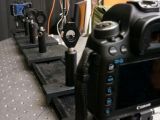At present, everyone suffering from a vision deficiency has to either live with their condition or get a pair of corrective glasses or contact lenses. A few years from now, though, such things may no longer be necessary.
Granted, that's not altogether true. People who want to read from an actual book, or those who need to wear glasses permanently rather than just for reading, will need to get such things, or contacts, anyway.
However, it is the belief of scientists from the University of California that electronic screens, like LCDs, OLEDs and any others, will be able to compensate for your vision problems themselves.
It should be noted that, even though the scientific article was published by the MIT Technology Review website, the work belongs to the people from the University of California.
The idea is that a plastic screen containing thousands of tiny holes would be placed over a screen, like that of an iPod Touch. The research specifically named the device, but the concept should be applicable to all screens, including monitors, TVs and laptop panels.
The plastic screen would work in tandem with a software whose role would be to adjust the light shown by each pixel, control how the light reaches your eyes in other words. Thus, the system could recreate a very sharp image.
The research team calls the idea a Light Field Display. The technology is likened to a pair of glasses, but in reverse, because the system can understand how the eye distorts what's shown on the screen and adjusts the picture accordingly.
A setup involving a Canon DSLR camera was used to simulate someone with a range of common vision problems. The technology responded as intended.
Presumably not just glasses wearers but even people suffering from more serious conditions could benefit from the advancement. However, in all cases, the screen will have to be tuned to the viewer's eyes and their focal length. Unfortunately, this means that if you sit too far away or too close, you'll end up seeing blurs. Eye-tracking technology might have to be integrated to compensate for our natural tendency to move around.
Either way, the technology is several years off, because it needs the screen addon to have a very high pixel density, twice that of the iPod touch (about 650 pixels per inch). Doable on monitors/TVs, but not on smartphones.
There is one problem that may never be surmounted though: the fact that the screen needs to be tuned for specific people means that a second or third person trying to look at the screen will have to live with the disappointment of seeing a foggy, irregular mess.

 14 DAY TRIAL //
14 DAY TRIAL // 
